In their just-published September-October Newsletter, Greek NGO MOm reports the births of 29 monk seal pups to date this breeding season: 11 in the Cyclades, 8 on the island of Evia and 5 each in the Ionian and the Dodecanese. The pup counts form part of population monitoring in specific areas of Greece, in an attempt to gather information on overall trends. No pup count information has been released from the National Marine Park of Alonnisos, Northern Sporades, where no population monitoring appears to have been conducted for several years — apparently the victim of funding cut-backs.
Automatic cameras record monk seals in the Desertas Islands
Rosa Pires, Parque Natural da Madeira
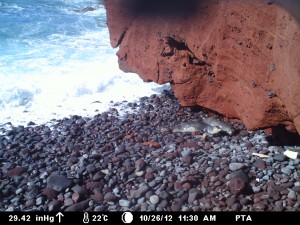
Over recent years, camera monitoring systems have been installed on several occasions in Madeira’s Desertas Islands, yet failed to achieve the desired results.
This year, however, we obtained the first images of monk seals on site using a simple system, comprising an automatic camera.
On 26 October 2012, the system captured the first pup of the reproductive season — barely one day old.
The calf, a female, is healthy and being cared for by two females who share the role of mother. It is thought possible that one of them may have previously lost her own calf.
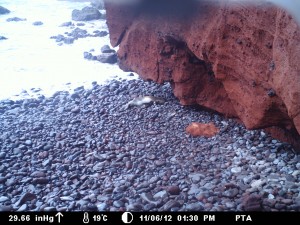
It is hoped that the initiative, undertaken through the BES Biodiversity award, with the technical assistance of Spanish organization CBD-Habitat, will allow more effective monitoring of monk seals both on beaches and in caves. The system is also expected to prove its value during the current stormy season, which often prevents or inhibits firsthand observation.
By January or February 2013, we hope to have results from the camera system installed inside ‘Tabaqueiro’ — a maternity cave.
Monk seal fisheries interactions
Recent Publications
![]() González, Luis Mariano and de Larrinoa, Pablo Fernández. 2012. Mediterranean monk seal Monachus monachus distribution and fisheries interactions in the Atlantic Sahara during the second half of the 20th century: 1-9. DOI: 10.1515/mammalia-2012-0046, October 2012. [Online purchase €30 / $42]
González, Luis Mariano and de Larrinoa, Pablo Fernández. 2012. Mediterranean monk seal Monachus monachus distribution and fisheries interactions in the Atlantic Sahara during the second half of the 20th century: 1-9. DOI: 10.1515/mammalia-2012-0046, October 2012. [Online purchase €30 / $42]
Abstract
The most important surviving colony of the critically endangered Mediterranean monk seal (Monachus monachus) inhabits the Atlantic Saharan coast. The population has not recovered despite the cessation of commercial sealing in the second half of the 20th century. We report the distribution of the monk seals within the region from 1940 to 1989 and their interactions with fisheries, from data gathered through interviews of fishermen. Our study shows a notable decrease in the seals’ range during the study period. Observations of seals on open beaches and exposed rocks decreased, while observations in caves increased. Important negative interactions between monk seals and fisheries were detected, with the most frequent interactions being bycatch in gillnets and bottom trawl nets. Reports obtained from fishermen clearly indicate that the seals were still being deliberately killed on land during the 20th century, which likely caused the extirpation of seal populations hauling out on beaches. We recommend that mortality due to fishery bycatch be added as a contributing factor to the decline of the monk seal populations in the region from 1940 to 1989. We also recommend conservation measures such as the establishment of a permanent marine reserve along the Atlantic Coast of the Cap Blanc Peninsula.
Keywords: Atlantic Sahara; distribution; endangered species; Mediterranean monk seal; seal-fishery interactions.
DLNR, NOAA appeal for help in preventing entanglements
News release, US Department of Land and Natural Resources (DLNR), 5 October 2012
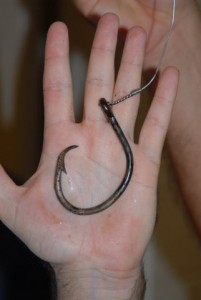
The Department of Land and Natural Resources and NOAA Fisheries announce that since the beginning of 2012, NOAA Fisheries, DLNR, and partners have responded to 13 seal hooking incidents involving ten individual Hawaiian monk seals.
Due to early reporting, seven of the 11 live cases ended successfully with intervention from authorized federal and state agency monk seal responders.
Two cases ended in the seal ridding itself without intervention, and although an intervention was attempted, one seal remains hooked to this day.
Three cases ended in deaths.
Most recently, on Oct. 2, 2012, the monk seal locally known as “RK54” was found dead near the Ninini Light house on Kauai. The seal swallowed a hook, became entangled in the line, and died. RK54 was born in April 2011 to RK22 (mother of the “famous” KP2 who resides at Waikiki Aquarium).
Continue reading “DLNR, NOAA appeal for help in preventing entanglements”
Naxos pup dies in rehab
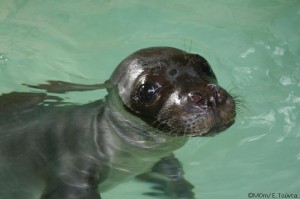 In a brief announcement on its Facebook page, Greek NGO MOm today announced that the orphaned monk seal pup rescued from Naxos on 19 September had died in its rehabilitation unit on Alonnisos.
In a brief announcement on its Facebook page, Greek NGO MOm today announced that the orphaned monk seal pup rescued from Naxos on 19 September had died in its rehabilitation unit on Alonnisos.
The statement reads in part: “[The pup] had unstable temperature and sugar levels and died in the afternoon of Friday, October 5th. Pending the results of the necropsy that took place yesterday at the Pathological Laboratory [sic] of the Aristotle University of Thessaloniki and the responsible veterinarian Dr. Anastasia Komninou, it was found that there was a generalised inflammation of the intestine, pneumonia and severe parasitic load. We expect more detailed information from the results of the virological, bacteriological and histological tests.”
There is no indication whether — or to what extent — the pup’s initial ordeal on Naxos, the lengthy evacuation off-island, or the substandard condition of the rehabilitation unit on Alonnisos, might have contributed to its ultimate demise [See Stranded monk seal rescued on Naxos — but was it harassed with good intentions first?].
Monk seal monitoring cameras installed on Desertas Islands, Madeira
by Rosa Pires, Parque Natural da Madeira Service
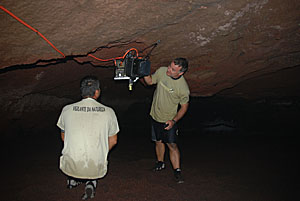 Funded by the Portuguese bank Espírito Santo’s Biodiversity Award, Parque Natural da Madeira Service has installed four cameras in the area most frequented by monk seals on land — in Tabaqueiro cave and on Tabaqueiro beach, on the Desertas Islands of Madeira.
Funded by the Portuguese bank Espírito Santo’s Biodiversity Award, Parque Natural da Madeira Service has installed four cameras in the area most frequented by monk seals on land — in Tabaqueiro cave and on Tabaqueiro beach, on the Desertas Islands of Madeira.
The PNMS team was assisted by CBD-Habitat Foundation of Spain, which has been developing and perfecting this method of monitoring the monk seal population since 1994, at the Côte des Phoques in the Western Sahara. The teams have been collaborating on monk seal conservation since 2008, under the framework of the “Action Plan for the Recovery of the Mediterranean Monk Seal in the Eastern Atlantic”, established under the auspices of the Bonn Convention.
The main goal of the Desertas camera initiative is to improve seal monitoring in the nature reserve, gaining a better knowledge of seal behaviour on land, while improving the photo-identification catalogue of this population. Should it prove successful, this monitoring method will be maintained in the Tabaqueiro area but also expanded to other areas that are used or have high probability of being used by monk seals. We eagerly await the next reproductive season — which begins in November — when seals will again use the Tabaqueiro area!
Portugal
